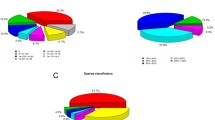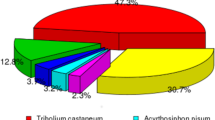Abstract
Chemosensory receptors in the dendritic membrane of olfactory cells are critical for the molecular recognition and discrimination of odorants. Tropidothorax elegans is a major pest of agricultural, ornamental, and medicinal plants. However, very little is known about olfactory genes in T. elegans. The purpose of this study was to obtain chemosensory receptor genes by sequencing the antennal transcriptome of T. elegans using Illumina sequencing technology. We identified 153 candidate chemosensory receptors, including 121 olfactory receptors (including one olfactory receptor co-receptor), 10 ionotropic receptors (including one IR8a and one IR25a), and 22 gustatory receptors (GRs). TeleOR76, 104 and 112 displayed more highly expression level than TeleOrco. Other TeleGR genes were expressed at very low levels except TeleGR1 and 20. TeleIR76b was the most highly expressed among TeleIR genes. Our results provide valuable biological information for studies of the olfactory communication system of T. elegans.





Similar content being viewed by others
References
Kaupp UB (2010) Olfactory signalling in vertebrates and insects: differences and commonalities. Nat Rev Neurosci 11:188–200
Leal WS (2013) Odorant reception in insects: roles of receptors, binding proteins, and degrading enzymes. Annu Rev Entomol 58:373–391
Maida R, Proebstl T, Laue M (1997) Heterogeneity of odorant-binding proteins in the antennae of Bombyx mori. Chem Sens 22:503–515
Klein U (1987) Sensillum-lymph proteins from antennal olfactory hairs of the moth Antheraea polyphemus (Saturniidae). Insect Biochem Mol 17:1193–1204
Jacquin-Joly E, Vogt RG, François MC, Nagnan-Le Meillour P (2001) Functional and expression pattern analysis of chemosensory proteins expressed in antennae and pheromonal gland of Mamestra brassicae. Chem Sens 26:833–844
Leal WS (2012) Odorant reception in insects: roles of receptors, binding proteins and degrading enzymes. Annu Rev Entomol 58:373–391
Buck L, Axel R (1991) A novel multigene family may encode odorant receptors: a molecular basis for odor recognition. Cell 65:175–187
Benton R, Vannice KS, Vosshall LB (2007) An essential role for a CD36-related receptor in pheromone detection in Drosophila. Nature 450:289–293
Vosshall LB, Stocker RF (2007) Molecular architecture of smell and taste in Drosophila. Annu Rev Neurosci 30:505–533
Sato K, Pellegrino M, Nakagawa T, Nakagawa T, Vosshall LB, Touhara K (2008) Insect olfactory receptors are heteromeric ligand-gated ion channels. Nature 452:1002–1006
Wicher D, Schfer R, Bauernfeind R, Stensmyr MC, Heller R, Heinemann SH, Hansson BS (2008) Drosophila odorant receptors are both ligand-gated and cyclicnucleotide-activated cation channels. Nature 452:1007–1011
Hill CA, Fox AN, Pitts RJ, Kent LB, Tan PL, Chrystal MA, Cravchik A, Collins FH, Robertson HM, Zwiebel LJ (2002) G protein-coupled receptors in Anopheles gambiae. Science 298:176–178
Robertson HM, Warr CG, Carlson JR (2003) Molecular evolution of the insect chemoreceptor gene superfamily in Drosophila melanogaster. Proc Natl Acad Sci 100:14537–14542
Robertson HM, Wanner KW (2006) The chemoreceptor superfamily in the honey bee, Apis mellifera: expansion of the odorant, but not gustatory receptor family. Genome Res 16:1395–1403
Wanner KW, Robertson HM (2008) The gustatory receptor family in the silkworm moth Bombyx mori is characterized by a large expansion of a single lineage of putative bitter receptors. Insect Mol Biol 9:621–629
Dahanukar A, Lei YT, Kwon JY, Carlson JR (2007) Two Gr genes underlie sugar reception in Drosophila. Neuron 56:503–516
Dunipace L, Meister S, McNealy C, Amrein H (2001) Spatially restricted expression of candidate taste receptors in the Drosophila gustatory system. Curr Biol 11:822–835
Hiroi M, Marion-Poll F, Tanimura T (2002) Differentiated response to sugars among labellar chemosensilla in Drosophila. Zool Sci 19:1009–1018
Jones WD, Cayirlioglu P, Grunwald Kadow I, Vosshall LB (2007) Two chemosensory receptors together mediatecarbon dioxide detection in Drosophila. Nature 445:86–90
Kwon JY, Dahanukar A, Weiss LA, Carlson JR (2007) The molecular basis of CO2 reception in Drosophila. Proc Natl Acad Sci USA 104:3574–3578
Sato K, Tanaka K, Touhara K (2011) Sugar-regulated cation channel formed by an insect gustatory receptor. PNAS 108:11680–11685
Rimal S, Lee Y (2018) The multidimensional ionotropic receptors of Drosophila melanogaster. Insect Mol Biol 27:1–7
Benton R, Vannice KS, Gomez-Diaz C, Vosshall LB (2009) Variant ionotropic glutamate receptors as chemosensory receptors in Drosophila. Cell 136:149–162
Abuin L, Bargeton B, Ulbrich MH, Isacoff EY, Kellenberger S, Benton R (2011) Functional architecture of olfactory ionotropic glutamate receptors. Neuron 69:44–60
Rytz R, Croset V, Benton R (2013) Ionotropic Receptors (IRs): Chemosensory ionotropic glutamate receptors in Drosophila and beyond. Insect Biochem Mol Biol 43:888–897
Koh TW, He Z, Gorur-Shandilya S, Menuz K, Larter NK, Stewart S, Carlson JR (2014) The Drosophila IR20a clade of ionotropic receptors are candidate taste and pheromone receptors. Neuron 83:850–865
Hussain A, Zhang M, Ucpunar HK, Svensson T, Quillery E, Gompel N, Ignell R, Kadow ICG (2016) Ionotropic chemosensory receptors mediate the taste and smell of polyamines. PLoS Biol 14:e1002454
Li XY, Zhao XQ, Yin YQ, Chen AD, Bu WJ, Jiao KL, Li N, Hu Q (2015) Recognition of the nymph instars of eight common harmful stinkbug species in the fields. Plant Protect China 41:100–105
Song YQ, Sun HZ, Du J (2018) Identification and tissue distribution of chemosensory protein and odorant binding protein genes in Tropidothorax elegans Distant (Hemiptera: Lygaeidae). Sci Rep-UK 8:7803
Grabherr MG, Haas BJ, Yassour M, Levin JZ, Amit DA, Adiconis X et al (2011) Full-length transcriptome assembly from RNA-Seq data without a reference genome. Nat Biotechnol 29:644–652
Iseli C, Jongeneel CV, Bucher P (1999) ESTScan: a program for detecting, evaluating, and reconstructing potential coding regions in EST sequences. Proc Int Conf Intell Syst Mol Biol 7:138–148
Larkin MA, Blackshields G, Brown NP, Chenna R, McGettigan PA, McWilliam H et al (2007) Clustal W and Clustal X version 2.0. Bioinformatics 23:2947–2948
Xu P, Choo YM, DeLa RA, Leal WS (2014) Mosquito odorant receptor for DEET and methyl jasmonate. Proc Natl Acad Sci USA 111:16592–16597
Wang R, Zhang XM, Li HL, Guo XJ, Luo C (2016) Identification and expression profiling of five chemosensory protein genes in the whitefly MED, Bemisia tabaci. J Asia Pac Entomol 19:195–201
Xiao W, Yang L, Xu Z, He L (2016) Transcriptomics and identification of candidate chemosensory genes in antennae of Conogethes punctiferalis (Lepidoptera: Crambidae). J Asia Pac Entomol 19:911–920
Zhang YN, Ma JM, Sun L, Dong ZP, Li ZQ, Zhu XY, Wang Y, Wang L, Deng DG, Li JB (2016) Molecular identification and sex distribution of two chemosensory receptor families in Athetis lepigone by antennal transcriptome analysis. J Asia Pac Entomol 19:571–580
Kirkness EF, Haas BJ, Sun W, Braig HR, Perotti MA, Clark JM et al (2010) Genome sequences of the human body louse and its primary endosymbiont provide insights into the permanent parasitic lifestyle. Proc Natl Acad Sci USA 107:12168–12173
Smith CR, Smith CD, Robertson HM, Helmkampf M, Zimin A, Yandell M et al (2011) Draft genome of the red harvester ant Pogonomyrmex barbatus. Proc Natl Acad Sci USA 108:5667–5672
Zhang YN, Zhu XY, Zhang Q, Yin CY, Dong ZP, Zuo LH, Deng DG, Sun L, Li XM (2016) De novo assembly and characterization of antennal transcriptome reveal chemosensory system in Nysius ericae. J Asia-Pac Entomol 19:1077–1087
An XK, Sun L, Liu HW, Liu DF, Ding YX, Li LM, Zhang YJ, Guo YY (2016) Identification and expression analysis of an olfactory receptor gene family in green plant bug Apolygus lucorum (Meyer-Dür). Sci Rep-UK 6:37870
Xiao Y, Sun L, Ma XY, Dong K, Liu HW, Wang Q, Guo YY, Liu ZW, Zhang YJ (2017) Identification and characterization of the distinct expression profiles of candidate chemosensory membrane proteins in the antennal transcriptome of Adelphocoris lineolatus (Goeze). Insect Mol Biol 26:74–91
Engsontia P, Sanderson AP, Cobb M, Walden KK, Robertson HM, Brown S (2008) The red flour beetle’s large nose: an expanded odorant receptor gene family in Tribolium castaneum. Insect Biochem Mol Biol 38:387–397
Wang Z, Yang P, Chen D, Jiang F, Li Y, Wang X, Kang L (2015) Identification and functional analysis of olfactory receptor family reveal unusual characteristics of the olfactory system in the migratory locust. Cell Mol Life Sci 72:4429–4443
He M, Zhang YN, He P (2015) Molecular characterization and differential expression of an olfactory receptor gene family in the white-backed planthopper Sogatella furcifera based on transcriptome analysis. PLoS ONE 10:e0140605
Cao D, Liu Y, Walker WB, Li J, Wang G (2014) Molecular characterization of the Aphis gossypii olfactory receptor gene families. PLoS ONE 9:e101187
Sanchez-Gracia A, Vieira FG, Rozas J (2009) Molecular evolution of the major chemosensory gene families in insects. Heredity 103:208–216
Smart R, Kiely A, Beale M, Vargas E, Carraher C, Kralicek AV, Christie DL, Chen C, Newcomb RD, Warr CG (2008) Drosophila odorant receptors are novel seven transmembrane domain proteins that can signal independently of heterotrimeric G proteins. Insect Biochem Mol 38:770–780
Dong JF, Song YQ, Li WL, Shi J, Wang ZY (2016) Identification of putative chemosensory receptor genes from the Athetis dissimilis antennal transcriptome. PLoS ONE 11:e0147768
Andersson MN, Grosse-Wilde E, Keeling CI, Bengtsson JM, Yuen MM, Li M, Hillbur Y, Bohlmann J, Hansson BS, Schlyter F (2013) Antennal transcriptome analysis of the chemosensory gene families in the tree killing bark beetles, Ips typographus and Dendroctonus ponderosae (Coleoptera: Curculionidae: Scolytinae). BMC Genomics 14:198
Jacquin-Joly E, Legeai F, Montagne N, Monsempes C, Francois MC, Poulain J, Gavory F, Walker WB, Hansson BS, Larsson MC (2012) Candidate chemosensory genes in female antennae of the noctuid moth Spodoptera littoralis. Int J Biol Sci 8:1036–1050
Clyne PJ, Warr CG, Carlson JR (2000) Candidate taste receptors in Drosophila. Science 287:1830–1834
Acknowledgements
This research was funded by the National Natural Science Fund of China (31701788) and Science and Technology Project in Henan Province (202102110069).
Author information
Authors and Affiliations
Contributions
All authors contributed to research design and manuscript preparation. Conceived and designed the experiments: YQS and HZS. Performed the experiments: YQS and HZS. Analyzed the data: YQS, HZS and ZYS. Contributed reagents/materials/analysis tools: YQS, JYZ and ZYS. Wrote the paper: YQS and HZS. All authors read and approved the final manuscript.
Corresponding author
Ethics declarations
Conflict of interest
The authors declare no conflict of interest.
Ethical approval
All applicable international, national, and/or institutional guidelines for the care and use of animals were followed.
Additional information
Publisher's Note
Springer Nature remains neutral with regard to jurisdictional claims in published maps and institutional affiliations.
Supplementary Information
Below is the link to the electronic supplementary material.
Rights and permissions
About this article
Cite this article
Song, Y.Q., Gu, H.Z., Song, Z.Y. et al. Identification of candidate chemosensory receptors in the antennal transcriptome of Tropidothorax elegans. Mol Biol Rep 48, 3127–3143 (2021). https://doi.org/10.1007/s11033-021-06327-8
Received:
Accepted:
Published:
Issue Date:
DOI: https://doi.org/10.1007/s11033-021-06327-8




